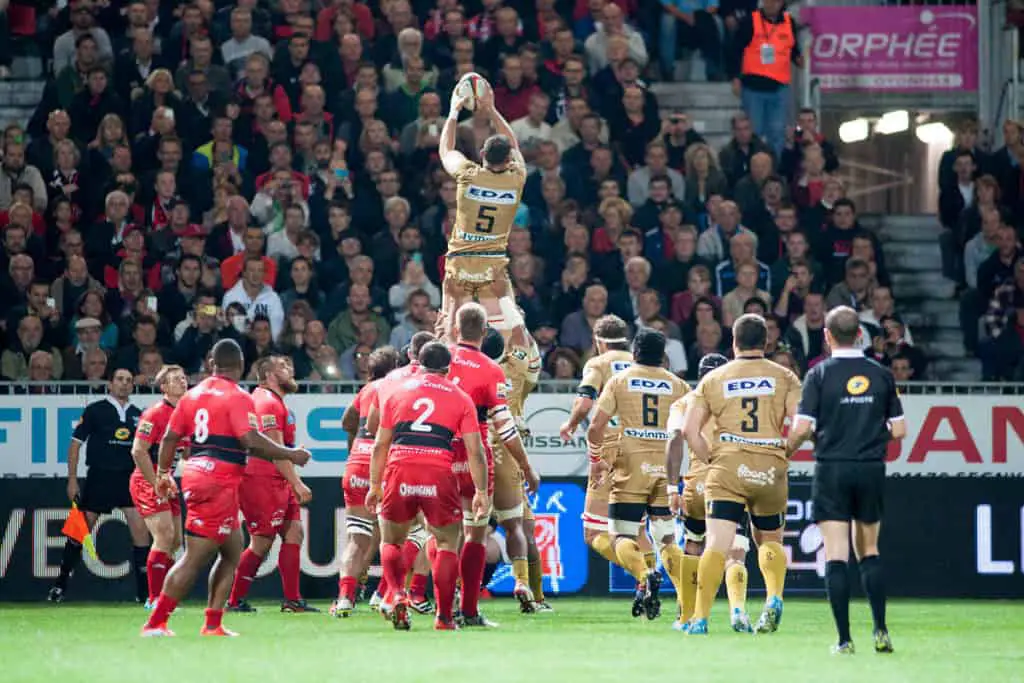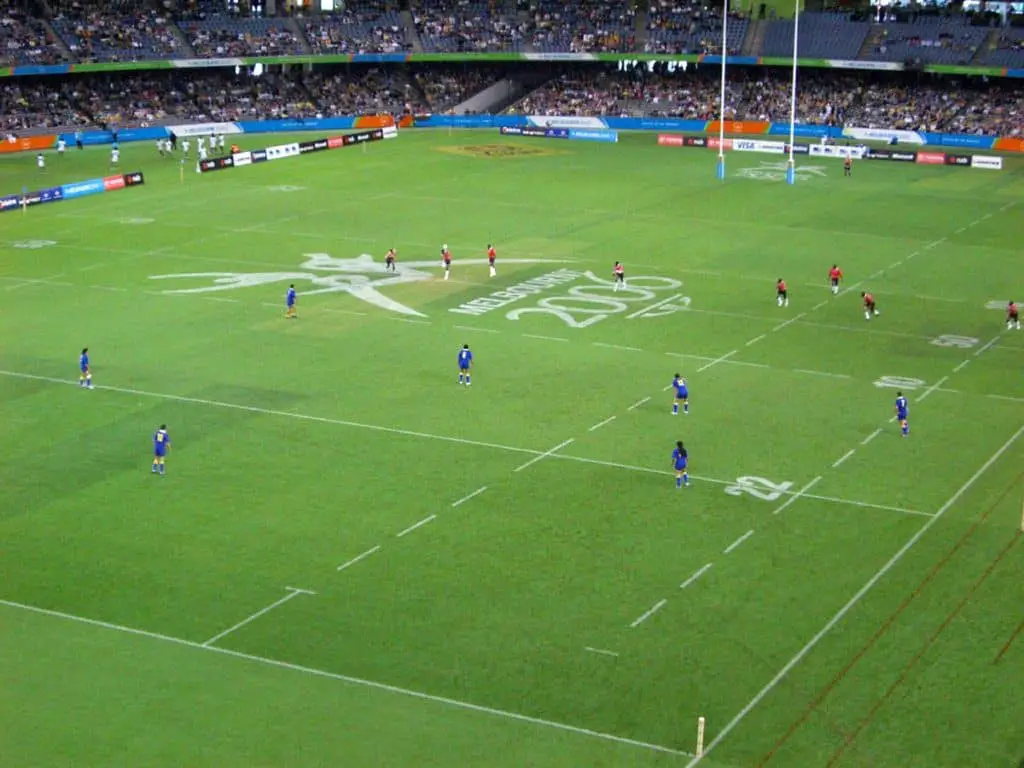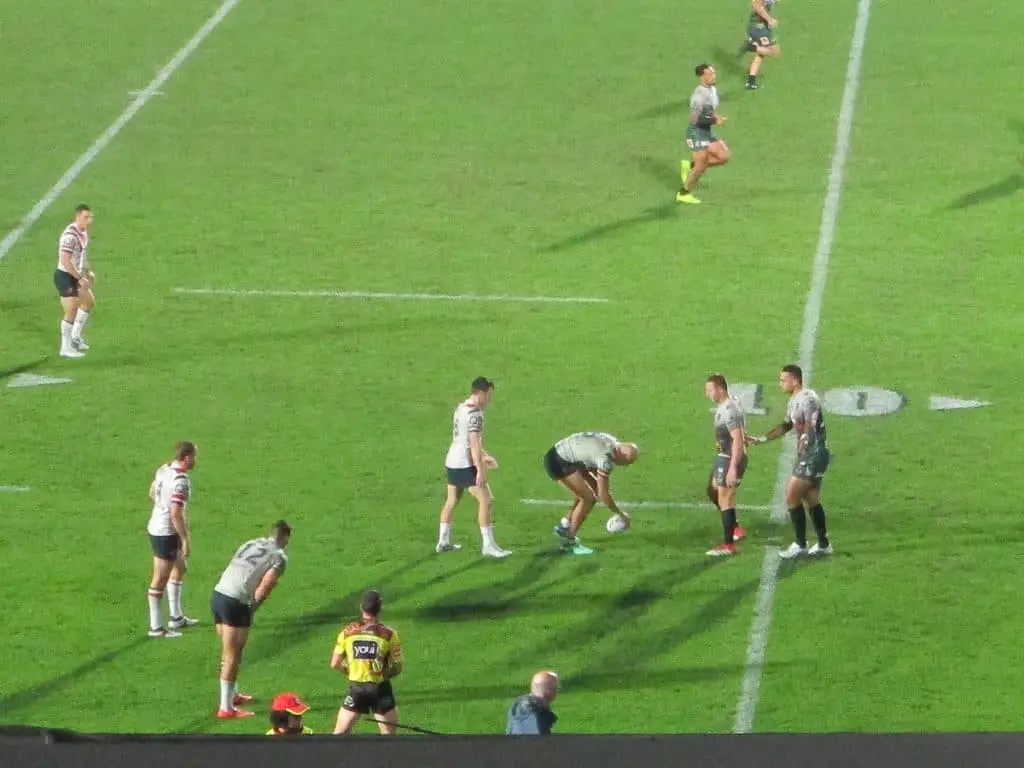To the casual observer flicking on the television it can be confusing to see so many different versions of rugby. There are in fact at least 10 different types of sport that use a rugby/egg shaped ball.
The main types of rugby that use the traditional oval shaped ball are: rugby union (15 a-side), rugby union 7s, rugby union 10s, rugby league (13 aside), touch rugby, beach rugby, tag rugby, and wheelchair rugby.
Let’s take a closer look at these different types of rugby as there are many differences between them, including the number of players, rules, seasonality, competition formats and a whole host more, so let’s get stuck in. We’ll go through each sport and explain the main features that differentiate it from the other types of rugby.
1. Rugby Union (15 a-side)
Popularity: The 15 a-side game is the most popular of all the versions of rugby attracting a fan base of 400 million television viewers annually.
Major international competitions: The Six Nations championship in the northern hemisphere competed for by England, Ireland, Scotland, Wales, France and Italy. The Rugby Championship in the northern hemisphere, competed for by New Zealand, Australia, Argentina and South Africa.
The most important competition, however, is the Rugby World Cup, competed fro every four years with the next being in France in 2023.
Major domestic competitions: The Gallagher Premiership in England, the United Rugby Championship (URC) in Ireland, Wales, Scotland and South Africa, the Top 14 in France, Super Rugby in the southern hemisphere competed for by provinces rather than clubs, Major League Rugby (MLR) in America and Japan Rugby League One in Japan.
Furthermore, there is the National Provincial Competition (NPC) in New Zealand and the Currie Cup in South Africa which sit below Super Rugby. Finally, there is the Heineken European Cup competed for by all clubs in Europe on an annual basis.
Unique features: The game is very technical with many laws being open to interpretation by the referee on the day, lineouts and scrums are very technically demanding requiring a great deal of skill and technique to get right. There is a lot of kicking in the game as winning and losing often comes down to which side can claim the most territory.
Seasonality: Rugby Union is traditionally a winter sport and the leagues in the northern hemisphere begin at the start of September and conclude around April/May time depending on whether teams make the play-offs or not.
In the southern hemisphere Super Rugby begins in February and ends in June with the NPC, Currie Cup and the minnow of Australian club rugby fit around that.
International matches are played in June/July by northern hemisphere teams traveling to the southern hemisphere and in November by southern hemisphere teams traveling north for what are called ‘Autumn Internationals’

2. Rugby Union 7s
Popularity: This version of the sport is becoming increasingly popular due to its more exciting nature and simplicity to learn and play.
Major events: This is a full summer olympic sport, a world cup every four years, and also a fully professional international circuit of tournaments played across at least nine, two day tournaments played in excotic locations around the world from Dubai to Las Vegas.
Unique features: Clearly teams are only 7 a-side which means that there is lots more space for players to run around in. This stretches players fitness and skill levels in a very different and more extreme way than rugby 15s. It is often thought of as being more entertaining and the unique atmosphere of rugby 7s events is worth going for alone!
Seasonality: The international 7s circuit runs from November to August but most countries have a series of tournaments or one off tournaments for players to build fitness during pre-season or as a bit of fun at the end of a season.
Most notable among these is the Premiership Rugby 7s tournament normally played during September and the Melrose 7s considered to be the ‘original’ sevens tournament but the Hong Kong 7s is the one to go to if you ever get a chance!

3. Rugby Union 10s
Popularity: This form of the sport is played more by amateur rugby teams, or older teams, i.e. vets teams because 7 a side rugby would be too demanding for them with too much space draining player energy levels very quickly making the game rather unenjoyable to play. Rugby 10s on the other hand provides more space but not too much so as to make it exhausting.
Major events: The Bangkok 10s tournament is a good example of a large 10s tournament designed largely for amateur players as is the Flanders 10s tournament billed as the largest 10s tournament in Europe.
Unique features: A hybrid of 7s and 15s, the emphasis is largely on enjoying social rugby typically over a long weekend.
Seasonality: Tournaments spring up year round but usually they are end of season festivals of rugby.
4. Rugby League
Popularity: A hugely popular sport in Australia with strong interest in New Zealand and the north of England.
Major events: A world cup is held every four years but arguably more significant games are the State of Origin series played in Australia which features the state of New South Wales playing against Queensland annually in a three game series.
Australian players make themselves available for the state from which they were born in producing fiercely competitive matches.
In the UK, the Rugby League Grand Final of the domestic league is a big day out similar to the final of the NRL (National Rugby League) domestic competition in Australia which is hugely popular and features the best rugby league teams on the planet outside of state of origin games.
Unique features: There are 13 players on each side providing more space then in union and there is also no competition for the ball during tackles, scrums, rucks and mauls like there is in union.
Instead, when players are tackled to the ground they simply roll the ball between their legs to a waiting player to continue the game. Teams are allowed to keep the ball for a series of 6 tackles before they have to hand the ball over to the opposition.
This lack of competition for the ball is the main differentiating factor between rugby league and union.
Rugby league became professional long before rugby union and has a stronger focus on entertaining fans and ball in play time, however, the numbers don’t lie rugby union is far more popular in every sense world wide.
Seasonality: Rugby league is largely a spring/summer sport in the UK and games begin in February and go through until September. This gives the advantage of drier weather for much of the season which generally makes for better handling and entertaining games.
In the southern hemisphere the NRL kicks off in March with games going through to September with the play off final being at the end of September, or early October.

You might also like: The difference between rugby 15s, 7s and league explained
5. Touch/Tag/Beach Rugby (Union and League)
Popularity: There are a number of versions of this game in both league and union with variations between countries but the sport looks set to grow as a game in its own right.
Two of the most prominent exist in Australia which seems to lead the way with Touch Football (rugby) https://touchfootball.com.au/ and Tough Rugby League https://www.trl.com.au/ which involves a stronger kicking aspect.
Major events: Tag Rugby and Touch Rugby both have world cup events but neither of which pull in the audiences in the same way as other forms of the sport.
Unique features: The lack of contact makes the game more welcoming for newcomers and reduces risk of injury greatly. As a result of the lack of contact and fewer players involved, typically only 6, there are far fewer rules and the game can be enjoyed as a more social sport.
With growing concern over the physicality of contact rugby, particularly in schools, Tough Rugby is in a good position to make strides in player numbers.
Seasonality: Played year round with considerable variations from country to country.
6. Wheelchair Rugby
Popularity: An increasingly popular paralympic sport for disabled athletes that attracts great interest during the paralympics due to its unusually aggressive nature. Sometimes known as ‘Murder Ball’ due to a documentary of that name being produced about the sport in 2005 which drew attention to the game.
Major events: Paralympics games and a world cup event.
Main rules: Played indoors on a basketball sized court with 4 players on court at a time of mixed genders.
Unique features: Contact is allowed and actively encouraged to tackle opposition players in their wheelchairs leading to quite a spectacle and the determination of playersand skill level is another attractive factor.
Seasonality: Year round as played indoors.
You might also be intereste in reading: What Type of Sport is Rugby? Explainer
Other Oval Ball Sports
Further confusion between the different versions of rugby can be caused as there are yet more sports that use an oval shaped ball yet are not relted to rugby at all. Here are the main two culprits that you might see on television.
Australian Rules Football (AFL)
Popularity: AFL is an abbreviation for Australian rules football, or Australian football. It may also be called Aussie rules, or even referred to as just football or footy in Australia and is hugely popular in Australia. In fact 6.5 million watched Aussie Rules in Australia in 2020 1.8 million more than the also hugely popular NRL tournament. Outside of Australia though interest is minimal.
Major events: The annual Australian Football League comprises 22 rounds climinating in play offs and a final. A world cup does exist and the last one was held in 2017 but interest outside of Australia remains sparse.
Unique features: The game is played on a huge oval field similar to the size of a cricket ground by two sets of 18 players and is a full contact sport.
Seasonality: The season runs from March to September in Australia.

American Football (NFL)
Popularity: American Football, or Grid Iron is hugely popular in America with about 400 million fans worldwide. Annoyingly this game may also be called footy by some Americans and hence even more confusion with other rugby games such as league and Aussie rules football which may also be called footy.
Major events: The Super Bowl final is played in February and it is the culmination of the NFL competition featuring teams from across America.
Unique features: A similar shaped ball to union is used but the ball is thinner and more pointed enabling players to hold it in one hand more easily and importantly hurl it through the air at greater speeds.
Seasonality: Played from August through to February in America.
So there we have it, a round up of all the different versions of rugby and oval shaped ball sports that you may come across. Whichever sport catches your interest, remember, it is never too late to get involved! Get in touch with your local club and have a go! Fun, friends and fitness await!
You might also like: 10 Tips For Beginner Rugby Players
Image credits
The New Zealand Haka, 江戸村のとくぞう, CC BY-SA 4.0, via Wikimedia Commons
Fiji Rugby Sevens, Melbourne, learza, CC BY-SA 2.0, via Wikimedia Commons
Blake ferguson, Play the ball, HufflepuffKade, CC BY-SA 4.0, via Wikimedia Commons
Hawthorn and Essendon players try to get their hands on the ball, HufflepuffKade, CC BY-SA 4.0, via Wikimedia Commons
US Oyonnax vs. Rugby Club Toulonnais, 3rd October 2014 Fanny Schertzer, CC BY 3.0, via Wikimedia Commons
